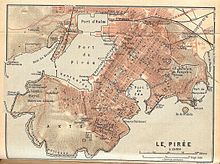Hippodamian scheme


The Hippodamian Scheme , or Hippodamian System , is a method used in ancient Greece to expand, re-establish or rebuild cities. It represents a further development of the existing city model strips, with scale in a grid plots and central agora . Rectangular parcels, set in double-row blocks, are accessed by wide main streets ( plateiai ) and narrower side streets ( stenopoi ) crossing these at right angles . Typhouses guarantee optimal property utilization and equal living standards. Hippodamus of Miletus developed it from the idea of the equality of all citizens, the Isonomia .
In modern urban architecture, the expression square grid type is also used for a street plan in the Hippodamian system.
In 479 BC After the destruction by the Persians , the city of Miletus was rebuilt according to the Hippodamian system in blocks of three to two parcels. 352 BC Chr. Was Priene according to the harmony laws of Pythagoras and the Hippodamian system built accordingly.
This principle was adopted in the Roman cities ( Augusta Treverorum , CCAA , Leptis Magna etc.).
Individual evidence
- ↑ Jürgen Hotzan, dtv Atlas City , German paperback publishing house, Munich 1997, ISBN 3-423-03231-6